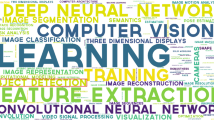Abstract
Target detection is now a hot research direction in the field of computer vision, where we can find applications for national defense, security, and medical security. Currently, there are many target detection algorithms, such as Fast R-CNN, Faster R-CNN, YOLOv3, and SSD. Among them, the YOLOv3 algorithm treats target detection as a regression problem and recognizes the entire image, which effectively improves the detection speed. The backbone network uses a residual structure to significantly increase network depth and balance accuracy. Currently, the international community has agreed to use new energy technologies to solve energy and environmental problems. At the same time, the energy consumption of urban buildings is one of the main reasons for energy consumption. The solar energy on the roof of the building has no pollution and noise and is easy to collect. Now, it has become one of the new energy technologies that are very suitable for applications in people’s residential areas. The combination of advanced educational theories and modern information technology is the direction of the development of English vocabulary education. It combines POA and modern technology and integrates advanced concepts such as output drive and input to promote learning and other advanced concepts into English vocabulary teaching. It plays a role in promoting. At the same time, it can also find problems in learning English vocabulary and develop related software theory and technology. According to the specific needs of learners, combined with the development of modern technology, it involves an English vocabulary learning software, which is based on the Android mobile teaching platform and innovates a variety of memory methods to help learners.



















Similar content being viewed by others
Change history
04 November 2021
This article has been retracted. Please see the Retraction Notice for more detail: https://doi.org/10.1007/s12517-021-08703-x
28 September 2021
An Editorial Expression of Concern to this paper has been published: https://doi.org/10.1007/s12517-021-08471-8
References
Ahmad AB (2014) Evaluation of groundwater quality index for drinking purpose from some villages around Darbandi khan district, Kurdistan Region-Iraq. IOSR J Agric Vet Sci 7:34–41
Arkhangelsk Hydrometeorological Observatory (1968) USSR climate reference book, issue 1, Arkhangelsk and Vologda regions, Karelian and Komi ASSR, part 2, air and soil temperature, 360 p. (in Russian)
Bobkov A, Panidi E, Torlopova N, Tsepelev V (2015) NDVI dynamics of the taiga zone in connection with modern climate changes. Int Arch Photogramm Remote Sens Spat Inf Sci XL-7(W3):157–163 https://doi.org/10.5194/isprsarchives-XL-7-W3-157-2015
Bons CA (ed) (2018) Ganga river basin planning assessment report. Main volume and appendices. Deltares with AECOM and FutureWater for the World Bank and the Government of India, Report 1220123–002-ZWS-0003
Csabragi A, Molnar S, Tanos P, Kovacs J (2017) Application of artificial neural networks to the forecasting of dissolved oxygen content in the Hungarian section of the river Danube. Ecol Eng 100:63–72. https://doi.org/10.1016/j.ecoleng.2016.12.027
Goetz SJ, Mack MC, Gurney KP, Randerson JT, Houghton RA (2007) Ecosystem responses to recent climate change and fire disturbance at northern high latitudes: observations and model results contrasting northern Eurasia and North America. Environ Res Lett 2(4):045031. https://doi.org/10.1088/1748-9326/2/4/045031
Hur J, Cho J (2012) Prediction of BOD, COD, and total nitrogen concentrations in a typical urban river using a fluorescence excitation-emission matrix with PARAFAC and UV absorption indices. Sensors 12:972–986
Kumar A, Verma A, Gokhale AA, Bhambri R, Misra A, Sundriyal S, Dobhal DP, Kishore N (2018a) Hydrometeorological assessments and suspended sediment delivery from a central Himalayan glacier in the upper Ganga basin. Int J Sediment Res 33(4):493–509
Kumar A, Tiwari SK, Verma A, Gupta AK (2018b) Tracing isotopic signatures (δD and δ18O) in precipitation and glacier melt over Chorabari Glacier–Hydroclimatic inferences for the Upper Ganga Basin (UGB), Garhwal Himalaya. J Hydrol Reg Stud 15:68–89
Mekonnen MM, Hoekstra AY (2016) Four billion people facing severe water scarcity. Sci Adv 2:e1500323
Mia MY, Sultana R, Rahman MM, Sarker MSA (2017) Physico-chemical parameters and heavy metal concentration of the Turag River water, Bangladesh. BOUJARD 9(1&2):13–25
Ministry of Water Resources (2014) Watershed Atlas of India. http://indiawris.gov.in/downloads/Watershed_Atlas_of_India.pdf. Accessed 25 September 2016
Panidi E, Tsepelev V, Torlopova N, Bobkov A (2016) Mapping of the land cover spatiotemporal characteristics in northern Russia caused by climate change. Int Arch Photogramm Remote Sens Spat Inf Sci XLI-B8:997–1002. https://doi.org/10.5194/isprs-archives-XLI-B8-997-2016
Shang X, Zhao J, Zhang H (2019) Obtaining high-resolution seabed topography and surface details by co-registration of side-scan sonar and multibeam echo sounder images. Remote Sens 11(12):1496. https://doi.org/10.3390/rs11121496
Shirzad A, Tabesh M, Farmani R (2014) A comparison between performance of support vector regression and artificial neural network in prediction of pipe burst rate in water distribution networks. KSCE J Civ Eng 18(4):941–948. https://doi.org/10.1007/s12205-014-0537-8
Soleymani SA, Goudarzi S, Anisi MH, Hassan WH, Idris MYI, Shamshirband S, Mohamednoor N, Ahmedy I (2016) A novel method to water level prediction using RBF and FFA. Water Resour Manag 30(9):3265–3283. https://doi.org/10.1007/s11269-016-1347-1
Tare V, Singh YAV, Bose P (2003) Analysis of photosynthetic activity in the most polluted stretch of river Ganga. Water Res 37:67–77
Vermote E (2015) MOD09A1 MODIS/Terra surface reflectance 8-day L3 global 500m SIN grid V006 [data set], NASA EOSDIS Land Processes DAAC. https://doi.org/10.5067/MODIS/MOD09A1.006
Yu S, Jia S, Xu C (2017) Convolutional neural networks for hyperspectral image classification. Neurocomputing 219:88–98
Zhang HW, Zhu ZJ, Huo BJ (2013) Water flowing fractured zone height prediction based on improved FOA-SVM. China Saf Sci J 23(10):10–15
Zhang F, Du B, Zhang L, Zhang L (2016) Hierarchical feature learning with dropout k-means for hyperspectral image classification. Neurocomputing 187:75–82
Author information
Authors and Affiliations
Corresponding author
Ethics declarations
Conflict of interest
The author declares no competing interests.
Additional information
Responsible Editor: Sheldon Williamson
This article is part of the Topical Collection on Environment and Low Carbon Transportation
This article has been retracted. Please see the retraction notice for more detail: https://doi.org/10.1007/s12517-021-08703-x"
About this article
Cite this article
Jin, Y. RETRACTED ARTICLE: Evaluation of solar energy potential based on target detection and design of English vocabulary teaching platform. Arab J Geosci 14, 1494 (2021). https://doi.org/10.1007/s12517-021-07726-8
Received:
Accepted:
Published:
DOI: https://doi.org/10.1007/s12517-021-07726-8




